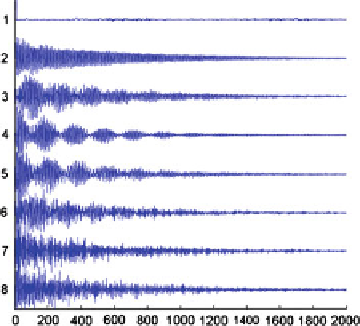Information Technology Reference
In-Depth Information
Fig. 5.2 Signals measured in
an impact-echo experiment
The quality control problem approached herein consisted of classifying several
solid materials that had a parallelepiped shape in homogeneous and different
defective classes. The proposed ICA mixture model was tested using an extensive
set of impact-echo signals that were extracted from 3D finite element models and
lab specimens of a series 2,000 aluminium alloy. This was done because in order
to perform controlled and extensive experiments. The models and specimens were
classified into four levels (from general to detailed classes) with the lowest level of
detail having up to 12 classes. The four classification levels were the following: (i)
Material condition: homogeneous, one defect, multiple defects; (ii) Kind of defect:
homogeneous, hole, crack, multiple defects (iii) Defect orientation: homogeneous,
hole in X axis or Y axis, crack in XY, ZY, or XZ planes, multiple defects; and (iv)
Defect dimension: homogeneous, passing through or half-passing through holes
and cracks of classification level iii, multiple defects.
Figure
5.3
shows outline examples of six of the classes where the defective
materials were classified. The other classes corresponded to the homogeneous
class and half-passing through versions of the one-defect classes of Fig.
5.3
. Note
that the multichannel impact-echo system with the location of the eight acceler-
ometers a1
a8 that were used as sensors is depicted for one of the material
classes. The data acquisition system has eight channels and one of them (channel
a1) is used to measure the impact signal. Holes are /=1 cm., and cracks are
vertical and extend from the left side to the bulk centre and are 5 mm. wide.
The defects were located at different positions within the pieces, and, in the case
of multiple-defect materials, the numbers of defects varied from 2 to 3. The set of
simulated and experimental signals were classified using the ICAMM-based clas-
sifier Mixca [
20
], LDA, and MLP 0. The results show that the impact-echo mass
spectra fit the ICA mixture modelling. Thus, the theoretical and experimental results
of this section provide a basis to undertake experiments at the industrial level.
Although the experiments are focused on specimens of aluminium alloy, there
are many potential applications with other kinds and sizes of materials. For
instance, in [
21
], we reported experimental work in the diagnostic of block-sized

Search WWH ::

Custom Search